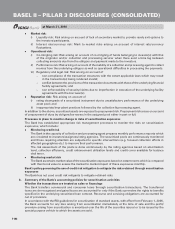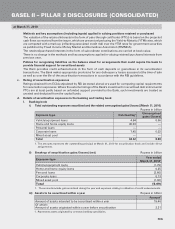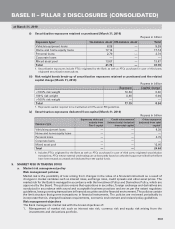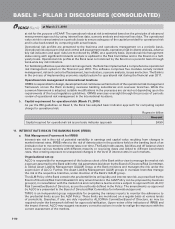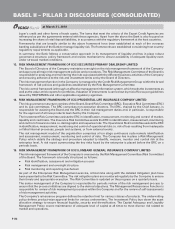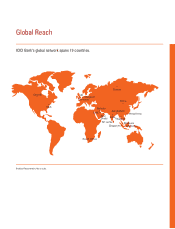ICICI Bank 2010 Annual Report Download - page 193
Download and view the complete annual report
Please find page 193 of the 2010 ICICI Bank annual report below. You can navigate through the pages in the report by either clicking on the pages listed below, or by using the keyword search tool below to find specific information within the annual report.
F113
12. LIQUIDITY RISK
Liquidity risk is the risk of inability to meet financial commitments as they fall due, through available cash flows
or through sale of assets at fair market value. It is the current and prospective risk to the Bank’s earnings and
equity arising out of inability to meet the obligations as and when they become due. It includes both, the risk of
unexpected increases in the cost of funding an asset portfolio at appropriate maturities as well as the risk of being
unable to liquidate a position in a timely manner at a reasonable price.
The goal of liquidity risk management is to be able, even under adverse conditions, to meet all liability repayments
on time and to fund all investment opportunities by raising sufficient funds either by increasing liabilities or by
converting assets into cash expeditiously and at reasonable cost.
Organisational set-up
The Bank manages liquidity risk in accordance with its ALM Policy. This policy is framed as per the extant regulatory
guidelines and is approved by the Board of Directors. The ALM Policy is reviewed periodically to incorporate
changes as required by regulatory stipulation or to realign with changes in the economic landscape. The ALCO
of the Bank formulates and reviews strategies and provides guidance for management of liquidity risk within the
framework laid out in the ALM Policy. The Risk Committee of the Board has oversight on the ALCO.
Risk measurement and reporting framework
The Bank proactively manages liquidity risk as a part of its ALM activities. The Bank uses various tools for
measurement of liquidity risk including the statement of structural liquidity (SSL), dynamic liquidity gap statements,
liquidity ratios and stress testing through scenario analysis.
The SSL is used as a standard tool for measuring and managing net funding requirements and assessment of
surplus or shortfall of funds in various maturity buckets in the future. The cash flows pertaining to various assets,
liabilities and off-balance sheet items are placed in different time buckets based on their contractual or behavioural
maturity. The SSL is prepared periodically for the domestic and international operations of the Bank and the
utilisation against gap limits laid down for each bucket are reviewed by ALCO.
The Bank also prepares dynamic liquidity gap statements, which in addition to scheduled cash flows, also considers
the liquidity requirements pertaining to incremental business and the funding thereof. The dynamic liquidity gap
statements are prepared in close coordination with the business groups, and cash flow projections based on the
same are presented to ALCO periodically. As a part of the stock and flow approach, the Bank also monitors various
liquidity ratios, and limits are laid down for these ratios under the ALM Policy.
Further, the Bank has a Board approved liquidity stress testing framework, as per which the Bank gauges its liquidity
position under a range of stress scenarios. These scenarios cover Bank specific and market-wide stress situations
and have been designed for the domestic and the international operations of the Bank. The potential impact on
the Bank’s financial position for meeting the stress outflows under these scenarios is measured and is subject to
a stress tolerance limit specified by the Board. The results of liquidity stress testing are reported to ALCO on a
monthly basis.
The Bank has also framed a Liquidity Contingency Plan (LCP) which serves as a framework for early identification
and calibrated action in the event of tight liquidity conditions. The LCP includes various triggers which are monitored
regularly, and lays down the mechanism for escalation, remedial action and crisis management until return
to normalcy.
Liquidity management
The Bank has diverse sources of liquidity to allow for flexibility in meeting funding requirements. For the domestic
operations, current accounts and savings deposits payable on demand form a significant part of the Bank’s funding
and the Bank is working with a concerted strategy to sustain and grow this segment of deposits along with retail
term deposits. These deposits are augmented by wholesale deposits, borrowings and through issuance of bonds
and subordinated debt from time to time. Loan maturities and sale of investments also provide liquidity. The Bank
holds unencumbered, high quality liquid assets to protect against stress conditions.
For domestic operations, the Bank also has the option of managing liquidity by borrowing in the inter-bank market on
a short-term basis. The overnight market, which is a significant part of the inter-bank market, is susceptible to volatile
interest rates. To limit the reliance on such volatile funding, the ALM Policy has stipulated limits for borrowing and
lending in the inter-bank market. The Bank also has access to refinancing facilities extended by the RBI.
For the overseas operations too, the Bank has a well-defined borrowing program. The US dollar is the base currency
for the overseas branches of the Bank, apart from the branches where the currency is not freely convertible. In order
to maximise the borrowings at reasonable cost, liquidity in different markets and currencies is targeted. The wholesale
borrowings are in the form of bond issuances, syndicated loans from banks, money market borrowings, inter-bank
bilateral loans and deposits, including structured deposits. The Bank also raises refinance from banks against the
BASEL II – PILLAR 3 DISCLOSURES (CONSOLIDATED)
at March 31, 2010



